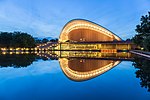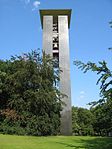Federal Ministry of the Interior and Community

The Federal Ministry of the Interior and for Community (German: Bundesministerium des Innern und für Heimat, German pronunciation: [ˈbʊndəsminɪsˌteːʁiʊm dɛs ˈɪnəʁən ʊnt fyːɐ̯ ˈhaɪ̯maːt] (listen); Heimat also translates to "homeland"), abbreviated BMI, is a cabinet-level ministry of the Federal Republic of Germany. Its main office is in Berlin, with a secondary seat in Bonn. The current minister of the Interior and Community is Nancy Faeser. It is comparable to the British Home Office or a combination of the US Department of Homeland Security and the US Department of Justice, because both manage several law enforcement agencies. The BMI is tasked with the internal security of Germany. To fulfill this responsibility it maintains, among other agencies, the two biggest federal law enforcement agencies in Germany, the Federal Police and the Federal Criminal Police Office. It is also responsible for the federal domestic intelligence agency, the Federal Office for the Protection of the Constitution.
Excerpt from the Wikipedia article Federal Ministry of the Interior and Community (License: CC BY-SA 3.0, Authors, Images).Federal Ministry of the Interior and Community
Alt-Moabit, Berlin Moabit
Geographical coordinates (GPS) Address External links Nearby Places Show on map
Geographical coordinates (GPS)
| Latitude | Longitude |
|---|---|
| N 52.521388888889 ° | E 13.362222222222 ° |
Address
Bundesministerium des Innern und für Heimat
Alt-Moabit 140
10557 Berlin, Moabit
Germany
Open on Google Maps











